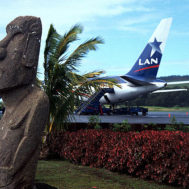
Images of Shusha’s Ghazanchetsots Cathedral hit by Azerbaijani forces on 8 October 2020 during the 2020 Nagorno-Karabakh conflict, 25 October 2020, ԶԻՆՈՒԺ MEDIA, CCA 3.0 Unported license.
The world faces the worst humanitarian crisis since the Russian invasion of Ukraine. Armenians in Karabakh, fearing executions and persecutions, as documented in the past, have fled en masse from Azerbaijan’s military offensive, refusing forced integration into a hostile country.
Not only are the lives of every Armenian in the region at risk, but the rich ancient history also risks destruction and forcible conversion. Already facing a state-sanctioned policy of cultural genocide, Armenian authorities look to protect much of their ancient heritage that will fall under Azerbaijani control as Baku uses the unstable Soviet-created borders to fuel its hegemony and manipulate history over the region.
Armenian Cultural Heritage at Threat from Neighbors
Azerbaijan’s unvetted control over Karabakh is changing the region’s history, including how it came under the control of Baku. For thousands of years, Armenians remained the majority ethnic group there through various empires that fought between their lands, such as the Persians, Greeks, Romans, Turks, Mongols, and Russians.
In the late Ottoman Empire, Armenians faced a brutal genocide in Turkey from which their population still has not recovered. Armenian heritage sites were targeted in the genocide, and a ‘Turkification’ policy occurred soon after to rewrite the history of Armenians in Eastern Anatolia.

Ghazanchetsots Cathedral Bell Tower Angel, 3/7/2018, photo Yerevantsi, CCA-SA 4.0 international license.
In a 1974 UNESCO report, only 913 historical Armenian monuments were left in modern-day Eastern Turkey. Of those 913,464 were destroyed (with traces unfound), 252 are in a state of ruin with minimal repair done by Ankara, and 197 are dilapidated, requiring immediate attention.
Ultimately, even after Ottoman rule ended, it was the border manipulations of the Soviet Union, particularly under Josef Stalin, that transferred the autonomous Karabakh region to the Azerbaijani SSR. Even when the area was transferred to Azerbaijan, it retained an Armenian majority, despite numerous pogroms and conflicts between Armenians and Azerbaijanis that set the stage for the perpetual conflict.
Cultural Genocide is a State-Sponsored Policy of Azerbaijan
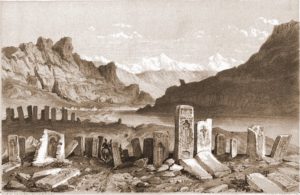
Armenian Cemetery in Julfa, 1830, Francis Rawdon Chesney, The Expedition for the Survey of the Rivers Euphrates and Tigris, 1850 [543], Wikimedia Commons.
Before the 2020 War and its “anti-terror” operations, Aliyev used the Azerbaijani military for heinous acts against Armenian cultural heritage, which were caught by satellite photos and photographs. From the mid-90s to early 2010s, the Azerbaijani military was witnessed and documented destroying the ancient Armenian gravesites of Julfa in Nakhichevan.
The province of Nakhichevan, located in modern-day Azerbaijan, was also an ancestral Armenian homeland, transferred to Baku by the Soviet Union, which purposely inflamed ethnic tensions. According to a Caucasus Heritage Watch and Hyperallergic report, over 108 medieval-era Armenian monasteries, religious sites, and cemeteries were eradicated in less than two decades.
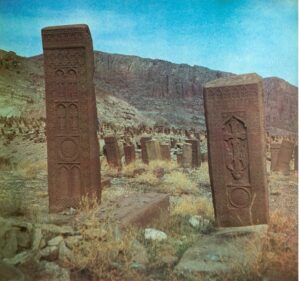
View of approximately 2000 khatchkars in the Old Julfa cemetery, prior to their bulldozing and complete destruction. Courtesy Argam Ayvazyan.
To put Azerbaijan’s complete ethnic cleansing of the Nakhichevan region into perspective, the ancient city of Palmyra in Syria still endures despite the monumental destruction of artifacts by ISIS. Today, almost no ancient Armenian heritage remains under Azerbaijani rule in Nakhichevan.
Further reports of the destruction of Armenian antiquities ensued in the aftermath of the 2020 war, such as the targeting of graves and the defacement and conversion of churches. Armenian priests of the Dadivank Monastery attempted to move priceless relics in correlation with Azerbaijan’s military advance, and Russian peacekeepers moved to the religious site after reports of sacking.
Azerbaijan’s Geopolitical Lobbying and Controversy in Cultural Erasure
Ilham Aliyev’s autocracy is known for its ‘caviar diplomacy’ and international lobbying efforts to sidestep international law, especially concerning cultural property. Caviar diplomacy involves lobbying foreign politicians, journalists, media, and other organizations with all-expense-paid trips to Baku, lavish gifts, and side payments.
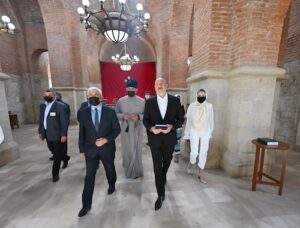
Azerbaijan President Ilham Aliyev and Mehriban Aliyeva visit the ‘Albanian’ Church of Blessed Virgin Mary in Nij settlement, Gabala. Photo azertag.az.
The first lady of Azerbaijan, Mehriban Aliyeva, was appointed as a goodwill ambassador of UNESCO to much controversy despite her husband having fueled the cultural genocidal policies of the state. Aliyeva’s role as a goodwill ambassador was controversial as UNESCO sent formal complaints to Baku for consistently stalling a site mission to Karabakh that would be conducted by the UNESCO team.
Azerbaijan’s Minister of Culture, Anar Karimov, blamed UNESCO for the lack of a site mission, even though Azerbaijan and Russian peacekeepers controlled all movements in the region. Azerbaijan’s blatant disregard for cultural heritage came to the forefront of international relations as the European Parliament adopted a resolution condemning Baku for its state-sponsored actions.
Aliyeva resigned from her goodwill ambassador position in 2022, citing ‘bias’ against Azerbaijan. However, it should be noted Azerbaijani officials still have not addressed international governing bodies on the visual evidence of the erasure and destruction of Nakhichevan.
International Cultural Protection Organizations Must Step Up
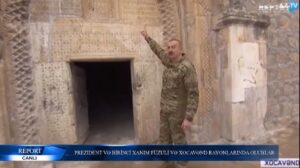
President of Azerbaijan, Ilham Aliev, during his visit to Nagorno-Karabakh in March 2021. He points to an inscription on a 12-17th century church in Tsakuri/Hunerli village and calling it fake. The oldest inscription from this church is on a khachkar mentioning the year 1198 . The inscription on the tympanum says “…I [Vardapet (abbot) Hakob] reconstructed the former church… in 1682.”
The fourth-century Amaras Monastery in Karabakh fell during the 2023 lightning advance by the Azerbaijani military, and church representatives raised the fear of its possible destruction or conversion to “Caucusian Albanian” heritage, an invented history which Baku appropriates to deny any Armenian historical references to the region.
Despite heavy lobbying, Baku has consistently violated the Second Protocol, ratified in 1999, of the Hague’s cultural protection, which could hold Azerbaijan criminally liable for continued negligent and malicious policies.
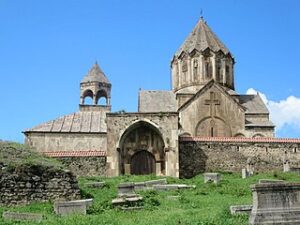
Popular belief holds that the head of John the Baptist is buried below the altar of 13th century Gandzasar Monastery near Vank, Republic of Nagorno Karabakh, 7 May 2017, Photo by David Stanley from Nanaimo, Canada.
International monitors are needed in the region for the safety of its people – and also its rich history that will be under threat. In the event of renewed signs of erasure and destruction, Baku must pay the price for state-sanctioned cultural property destruction through harsh sanctions.
The Aliev family has made inciting ethnic hatred and cultural destruction its public policy for decades. Now, consolidating control over Nakhichevan and Karabakh, Aliyev could write the final chapter of Armenian cultural erasure that has never recovered from the 1915 genocide and onwards. Cultural genocide is not only a significant loss for Armenians but for all of humanity, who will never get to witness such heritage ever again if history repeats itself.

Julian McBride, 2023.
Contributing author Julian McBride is a forensic anthropologist, independent journalist, and former U.S. Marine. He writes on the catastrophic impact of conflict on individuals, communities, and their cultural heritage. McBride is the founder and director of the Reflections of War Initiative (ROW).
 Ghazanchetsots Cathedral, in Shusha, Nagorno Karabakh, photo by Vladimer Shioshvili, 4 August 2007, CCA-SA 2.0.
Ghazanchetsots Cathedral, in Shusha, Nagorno Karabakh, photo by Vladimer Shioshvili, 4 August 2007, CCA-SA 2.0. 

